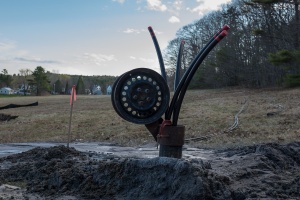
This is the geothermal borehole. Those four pipes form a loop that connects with the exchanger in the house.
We’re wrapping up well drilling week on Dash Landing. But before we talk about it, let’s start with a confession.
We do not have a good history with water.
Our Medford roof leaked. The basement flooded. Worst of all, our water pressure was barely above zero. God help the person who turned on a faucet while the other was showering. Watering a garden was out of the question. And a toilet flush brought the entire house to a standstill for a solid fifteen minutes. (Always fun during at dinner parties.)
We tried boosters, tanks and everything short of voodoo before finally taking the step of replacing the mainline to the house. Not perfect, but definitely better.
Flying Point Road brought a different adventure. Building a house on a tight budget and the whole “pay by the foot until we hit water” game of chance is a breathtaking combination. And drilling day lived up to that billing. 200 feet…300 feet…400 ft…500 ft. No water, but an incredible amount of money down a very deep hole in a short amount of time.
At 525 feet, our contractor — in a suggestion that will endear him to us forever — said “Stop drilling. We need to frack this damn thing.”
I know what you’re thinking.
“OhmygodfrackingispollutingdrinkingwateralloverthecountryItispureevil.”
And that’s why it’s important to realize that there are TWO kinds of hydrofracturing. One kind pumps all sorts of chemicals under pressure into bedrock. The rocks split and release natural gas. Nasty byproducts. Fouls drinking water. Probably pure evil.
But the other kind of hydrofracturing is much different. Same general principle, but instead of chemicals, the driller pumps plain water back into the well at roughly 2,000 pounds per square inch. That pressure opens up the surrounding rock and allows water to flow more freely. (There’s a great explanation here.)
So we ponied up the extra money for fracking. And it was nothing short of a Smokey Robinson miracle. What was unusable minutes earlier became a well that has worked flawlessly for nearly twenty years.
It was with this history and more than a little trepidation that we went into “Well Week” on Dash Landing.
The good news? This time we had two shots at it. We’d drill the first well to our geothermal requirement of 300′. (The number of geothermal wells — boreholes — and required depth is part of the system engineering process.) If we hit decent water before 300′, we’d use that one for drinking water and use the other for the borehole. If not, we’d move the rig and pray for better luck.
So after a bit of site work earlier in the week, the folks from Rolfe’s Well Drilling pulled up on Thursday morning and started drilling. 100 feet. 200 feet. 250 feet. 275 feet. 300 feet. A bit of water at 300 feet, but far short of anything we’d need for a water supply.
The curse is ALIVE.
Moved the rig to the new location, got things set up and called it a day. Started the drinking and the praying. Took only a small amount of solace in the parting words of the driller — “We’ve been doing this since 1966. It can be totally dry at 500′ in one spot. Move the rig 20′ and we can hit a gusher at a 100′. And there’s no rhyme or reason between them.”

Once the tubes are inserted, the geothermal borehole is “grouted.” Basically filled with a heat conducting mix of cement, sand and watery clay
It was soon clear that he had never worked for the Fullers because Friday morning brought Thursday all over again. 100 feet. 200 feet. 250 feet. A bit of water at 300 feet. A bit more at 350′. At 380′, we hit a gallon a minute — over the state minimum at that depth, but nothing to write home about.
And at that point, the Rolfe’s folks made new friends with this suggestion. “We can keep drilling, but there’s a chance of hitting salt water as we get below 400′. With just the two of you, this might be fine. But if you want more capacity, we could give fracking a try.”
Yes, please.
A few hours and dollars later, our one gallon per minute turned into four gallons. And that amount of flow at that depth will give us plenty of water for whatever strikes our fancy.
Another Fuller well. Another fracking miracle.
Next up, curtain drains and foundations.


Reading about YOUR adventures is far more entertaining than it was living OUR adventures. With the soothing effect of time, our adventures are now more humorous than they were then. But yours are still better.
Pingback: “If you can’t be in awe of Mother Nature, there’s something wrong with you” – Alex Trebek | A House In A Field